
Adaptations
Alces alces has some very unique adaptations that help it survive the cold, harsh winters, that help it when it is in water, and when it eats. These distinct adaptations are huge antlers, hooved feet, long legs, fur with many unique warming features, special gut modifications, special molars, and its sense of hearing and smell. Without all of these features, the moose would not be able to survive the cold winters of the environment it lives in.
Antlers
 Male moose grow antlers that are approximately five feet wide.
The purpose for having antlers is to attract females during the
rutting season (mating season). However, there is another purpose
for these huge bony extensions on their head. That purpose is to
warn a threatening source to back off. To do this, the moose will
lower its head to show off its antlers. That usually sends a good
message to the predator or other bull to not mess with it. During
the summer months, the moose’s antlers are covered in velvet. This
velvet is a skin that covers the growing antlers and supplies the
growing bone with blood and oxygen. The velvet will begin to dry out
and shed during the rutting season. To help with the shedding, the
moose will normally scrape its antlers on shrubs and tree bark. Once
the velvet is completely off, the antlers are matured and done
growing. Eventually, osteoclasts will start to eat away at the
bottom of the antlers and cause them to fall off. Antlers generally
fall off before the long winter because they take a lot of energy
and nutrients to keep them. They re-grow every year about
summertime. Cows tend to be attracted to bigger antlers because it
shows that the male can find food because it takes a lot of
nutrients to keep their antlers.
Male moose grow antlers that are approximately five feet wide.
The purpose for having antlers is to attract females during the
rutting season (mating season). However, there is another purpose
for these huge bony extensions on their head. That purpose is to
warn a threatening source to back off. To do this, the moose will
lower its head to show off its antlers. That usually sends a good
message to the predator or other bull to not mess with it. During
the summer months, the moose’s antlers are covered in velvet. This
velvet is a skin that covers the growing antlers and supplies the
growing bone with blood and oxygen. The velvet will begin to dry out
and shed during the rutting season. To help with the shedding, the
moose will normally scrape its antlers on shrubs and tree bark. Once
the velvet is completely off, the antlers are matured and done
growing. Eventually, osteoclasts will start to eat away at the
bottom of the antlers and cause them to fall off. Antlers generally
fall off before the long winter because they take a lot of energy
and nutrients to keep them. They re-grow every year about
summertime. Cows tend to be attracted to bigger antlers because it
shows that the male can find food because it takes a lot of
nutrients to keep their antlers.
Hoofed feet
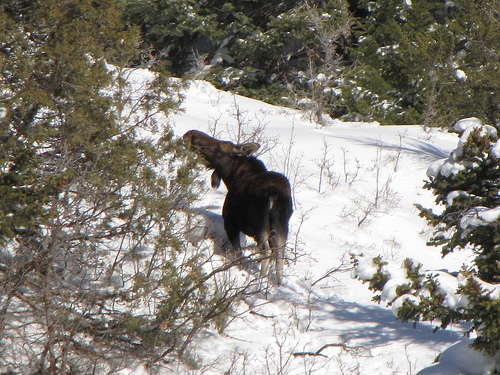 The adaptation of hoofed feet are vitally important for the moose
because they allow it to stay on top of deep snow and not sink into
it. They also allow the moose to get good footing and grip on hard,
soft, and even mushy surfaces. Each of the moose’s feet has four
toes: two large front ones and two small back ones. The tracks that
they leave behind are roughly six to ten inches long by four and a
half inches long. The hooves prevent sinking because they have large
surface area. These modified feet also aid in removing snow to
reveal food found under the snow during the winter. The moose’s feet
also aid in swimming.
The adaptation of hoofed feet are vitally important for the moose
because they allow it to stay on top of deep snow and not sink into
it. They also allow the moose to get good footing and grip on hard,
soft, and even mushy surfaces. Each of the moose’s feet has four
toes: two large front ones and two small back ones. The tracks that
they leave behind are roughly six to ten inches long by four and a
half inches long. The hooves prevent sinking because they have large
surface area. These modified feet also aid in removing snow to
reveal food found under the snow during the winter. The moose’s feet
also aid in swimming.
Long Legs
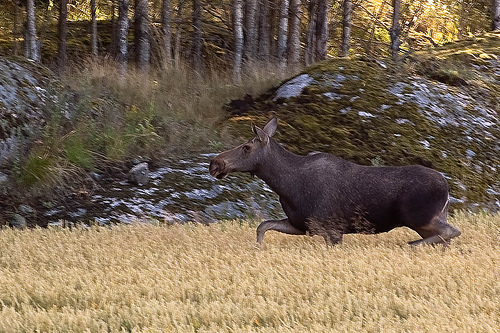 The moose’s long legs are very useful and they allow the moose to
run really fast (35 miles per hour) and to jump over obstacles, such
as fallen trees. They also help make moose one of the best swimming
land mammals alive! They can swim up to speeds of six miles per hour.
Standing high above the ground aids the moose in ability to reach
higher into trees for vegetation and with the detection of
predators. Being so tall lets the moose see over deep snow and tall
grasses. The moose can also use its legs as weapons for defense. If
a predator, another moose, or even a human get too close, it can
lash out its front leg in a sweeping motion or it can kick with its
hind legs, just like a horse. If given the opportunity, the moose
will stomp a predator to death.
The moose’s long legs are very useful and they allow the moose to
run really fast (35 miles per hour) and to jump over obstacles, such
as fallen trees. They also help make moose one of the best swimming
land mammals alive! They can swim up to speeds of six miles per hour.
Standing high above the ground aids the moose in ability to reach
higher into trees for vegetation and with the detection of
predators. Being so tall lets the moose see over deep snow and tall
grasses. The moose can also use its legs as weapons for defense. If
a predator, another moose, or even a human get too close, it can
lash out its front leg in a sweeping motion or it can kick with its
hind legs, just like a horse. If given the opportunity, the moose
will stomp a predator to death.
Fur
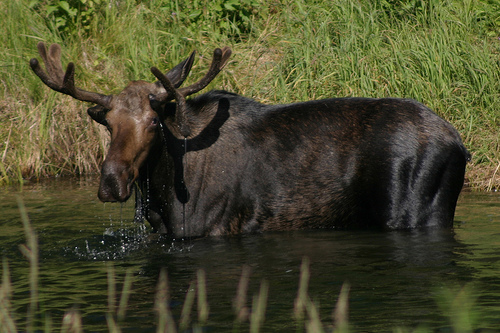 The fur on the moose is actually hollow. Why is it hollow? It
allows the moose to stay warm during the winter and makes the moose
more buoyant while swimming. The air is trapped inside the layer of
fur and also inside of each individual air, which prevents the moose
from losing heat and prevents cold air from reaching its skin. Since
each individual hair is hollow, they help the moose become more
buoyant. The moose needs to swim in the summer to stay cool and
being buoyant really helps the moose stay afloat. Due to this fur,
moose are better fitted to live in colder climates than in warm
climates. The moose sheds most of its fur and grows a new one each
spring. The hairs that are shed are the heavy guard hairs that act
as winter coats every year.
The fur on the moose is actually hollow. Why is it hollow? It
allows the moose to stay warm during the winter and makes the moose
more buoyant while swimming. The air is trapped inside the layer of
fur and also inside of each individual air, which prevents the moose
from losing heat and prevents cold air from reaching its skin. Since
each individual hair is hollow, they help the moose become more
buoyant. The moose needs to swim in the summer to stay cool and
being buoyant really helps the moose stay afloat. Due to this fur,
moose are better fitted to live in colder climates than in warm
climates. The moose sheds most of its fur and grows a new one each
spring. The hairs that are shed are the heavy guard hairs that act
as winter coats every year.
Gut Modifications
The main two parts of a moose’s gut that have adapted to their
way of life are the rumen and their long intestinal track. The rumen
is the first chamber that vegetation goes into after leaving the
esophagus. 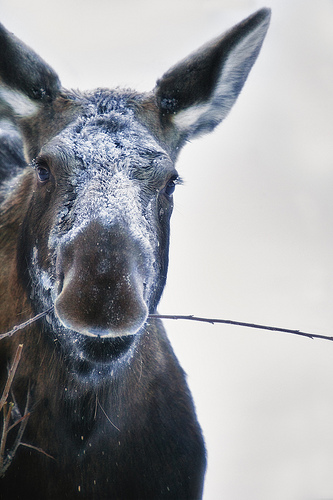 The purpose of this rumen is to help the moose
digest vegetation that it consumes. Since moose lack the enzyme cellulase, they have
microbial flora that digest it for them. When
the microbial flora breaks down the cellulose in the vegetation, it
creates methane gas as a byproduct. Typically the microbial flora
consists of many species of bacteria, protozoa, yeast, and other
species of fungi. After the microbial flora breaks the vegetation
down a bit, the moose regurgitates the vegetation. This material is
now called cud. After the cud arrives back in the moose’s mouth, the
moose chews it thoroughly a second time and swallows it. The
environment inside of the rumen is anaerobic, which means there is
no oxygen in it. The long intestinal track of the moose gives the
intestine more surface area for uptake of nutrients because plants
are very poor in nutritional value.
The purpose of this rumen is to help the moose
digest vegetation that it consumes. Since moose lack the enzyme cellulase, they have
microbial flora that digest it for them. When
the microbial flora breaks down the cellulose in the vegetation, it
creates methane gas as a byproduct. Typically the microbial flora
consists of many species of bacteria, protozoa, yeast, and other
species of fungi. After the microbial flora breaks the vegetation
down a bit, the moose regurgitates the vegetation. This material is
now called cud. After the cud arrives back in the moose’s mouth, the
moose chews it thoroughly a second time and swallows it. The
environment inside of the rumen is anaerobic, which means there is
no oxygen in it. The long intestinal track of the moose gives the
intestine more surface area for uptake of nutrients because plants
are very poor in nutritional value.
Head, Teeth, and Mouth
 The shape of the moose’s head is elongated. This helps aid in
feeding strategies such as bending over for water and reaching high
into trees. However, those are only side benefits to having such a
long head. The main reason is to allow the moose to feed underwater.
The moose’s nose has flaps that automatically close when the water
pressure is greater than the air pressure. The moose has 32 teeth,
which consists of 12 ridged molars, 12 premolars, 6 incisors and 2
canines. These teeth are grouped together in groups called the front
teeth (incisors and canines) and back teeth (molars and premolars).
When a moose eats, the incisors main job is to bring twigs into
their mouth then bit them off, and the back teeth are used for
chewing and grinding of the food. Interestingly, there is an open,
flat space between the front and back teeth called a
diastema. A
moose will grab twigs and put them sideways on this spot, and then
pull all the leaves off of it by moving its head sideways. From
here, the vegetation gets chewed by the molars and premolars then
swallowed the first time.
The shape of the moose’s head is elongated. This helps aid in
feeding strategies such as bending over for water and reaching high
into trees. However, those are only side benefits to having such a
long head. The main reason is to allow the moose to feed underwater.
The moose’s nose has flaps that automatically close when the water
pressure is greater than the air pressure. The moose has 32 teeth,
which consists of 12 ridged molars, 12 premolars, 6 incisors and 2
canines. These teeth are grouped together in groups called the front
teeth (incisors and canines) and back teeth (molars and premolars).
When a moose eats, the incisors main job is to bring twigs into
their mouth then bit them off, and the back teeth are used for
chewing and grinding of the food. Interestingly, there is an open,
flat space between the front and back teeth called a
diastema. A
moose will grab twigs and put them sideways on this spot, and then
pull all the leaves off of it by moving its head sideways. From
here, the vegetation gets chewed by the molars and premolars then
swallowed the first time.
Senses
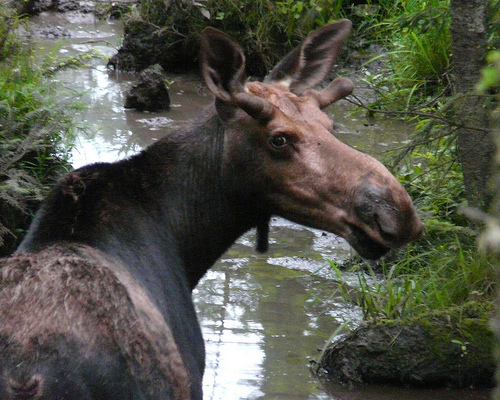 The moose's sense of hearing and smell are great adaptations
for the environment it lives in. Their sense of smell is
phenomenal and can detect the odor of a potential predator from
a long distance away. The moose's hearing is also very good.
They moose needs its hearing to act with its sense of smell to
detect danger. The moose's eyesight isn't particularly bad, its
more just the location of the eyes on the head that don't give
the moose a good range sight. Located on the sides of the head,
the eyes leave a huge blind spot in front of the moose. The
increased sense of hearing and smell is perfect for the
environment that the moose lives in because in a thick forest,
it is hard to see predators before it is too late. Hearing and
smelling gives the moose more time to run or more time to
prepare to fight the potential danger.
The moose's sense of hearing and smell are great adaptations
for the environment it lives in. Their sense of smell is
phenomenal and can detect the odor of a potential predator from
a long distance away. The moose's hearing is also very good.
They moose needs its hearing to act with its sense of smell to
detect danger. The moose's eyesight isn't particularly bad, its
more just the location of the eyes on the head that don't give
the moose a good range sight. Located on the sides of the head,
the eyes leave a huge blind spot in front of the moose. The
increased sense of hearing and smell is perfect for the
environment that the moose lives in because in a thick forest,
it is hard to see predators before it is too late. Hearing and
smelling gives the moose more time to run or more time to
prepare to fight the potential danger.
Go to Nutrition to see what the moose eats!
Back to Homepage

